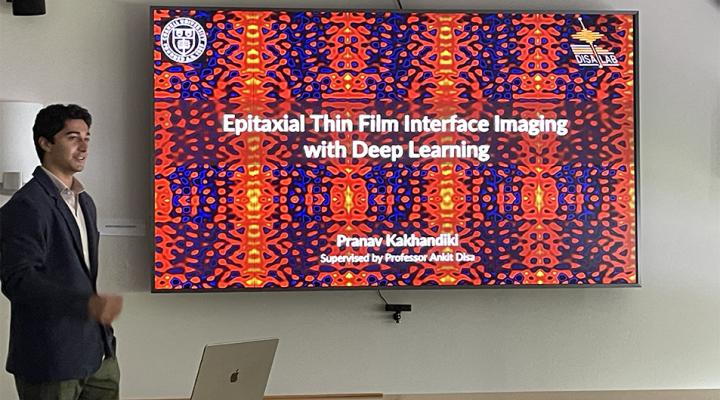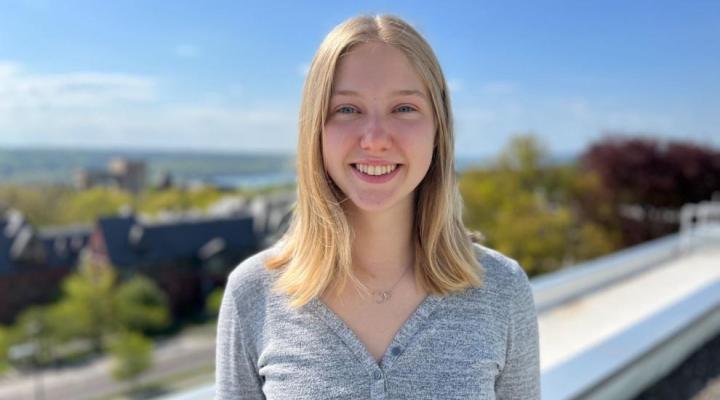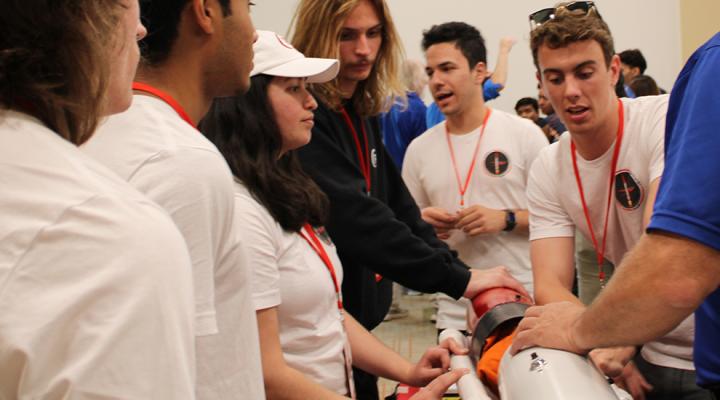Laila Reimanis, AEP ’24, is a senior from South Stafford, Vermont who won the Undergraduate Research Award from the Cornell Engineering Alumni Association in April, 2023. Despite her rigorous academic life, she also makes time for her other interests: horseback riding and working in her family’s vegetable gardens in Vermont, running and competing as a member of the Cornell Running Club, rock climbing, bicycling, and playing the flute in chamber groups on campus and with her father’s small rock band in Vermont. Laila shared with us some of her experiences at Cornell in the School of Applied and Engineering Physics, as well as her plans for the future.
Why Cornell, and why AEP in particular?
I was drawn to Cornell from the moment I first visited campus in my junior year of high school. My mom and I snuck into the labs in the basement of Baker and Clark and got lost (literally!) wandering the halls looking at research signs and posters. AEP’s cutting-edge research in a variety of disciplines inspired me because of my varied and combined interests in fundamental physics, materials science, and nanoscale engineering for renewable energy technology. I was drawn to AEP because I felt it could provide me with a strong background in physics that could be later applied to materials science and engineering.
What are your research passions?
I am passionate about research that makes a difference in global energy challenges or carbon sequestration to help mitigate the climate crisis. Increasing atmospheric CO2 levels continue to cause global warming at an alarming rate. Additionally, current renewable energy technologies cannot replace the need for liquid fuels to power large transportation vehicles. One solution to both of these problems is CO2 capture and conversion. In Professor Tobias Hanrath’s Energy Group (in the Smith School of Chemical and Biomolecular Engineering), I study electrochemical carbon dioxide reduction (eCO2R), which is a way to convert anthropogenic carbon dioxide emissions into hydrocarbon fuels. For this technology to be useful on an industrial scale, improvements are needed in efficiency, product selectivity, and durability. Using copper nanostructures in the catalyst has potential to improve eCO2R in all these realms. I work on designing, synthesizing, and testing mesostructured copper electrodes for electrochemical CO2 reduction.
When you reflect on your time in AEP and at Cornell, what stands out?
The passion that AEP students and professors have for physics is astounding. There is a strong emphasis on collaboration, and I’ve grown immensely by working with smart and talented peers who share my love of acquiring knowledge and solving problems. The research I am doing now is technically in chemical engineering and materials science, but these fields intersect heavily with each other and AEP, and with the knowledge I acquired in my AEP classes. I’ve found that the content and problem-solving abilities I learned and practiced as an AEP major are highly relevant to any physical sciences research.
What’s next?
was an intern at the National Renewable Energy Laboratory last summer and plan to return this summer to study crystalline thin films of gallium arsenide (GaAs) grown via hydride vapor phase epitaxy. GaAs is useful for lightweight, flexible, high-efficiency photovoltaics, but its cost is too great for use in most everyday applications. Hydride vapor phase epitaxy is a promising cost-reducing alternative to current industry-standard GaAs growth methods. After that, I will pursue a Materials Ph.D. at U.C. Santa Barbara, where I plan to study topological materials.





